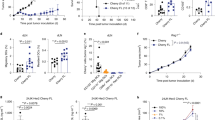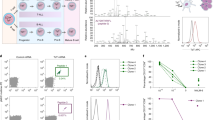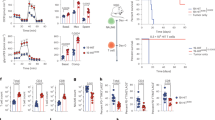Abstract
Primary human activated T lymphocytes were genetically grafted with chimeric T cell receptors (TCR). Three domain single chain (sc-) TCR as well as two chain (tc-) TCR gene constructs were derived from the melanoma-specific cytotoxic human T cell (CTL) clone 82/30, and linked to the CD3-ζ signaling element. Chimeric TCR α and β receptor genes were structurally designed to prevent pairing with endogenous TCR α and β chains in order to prevent the generation of unpredictable immune specificities. After transduction of polyclonally activated human peripheral blood lymphocytes with retroviral vectors harboring the chimeric receptor genes, genetically engineered cells specifically recognized and responded to MAGE-A1POS/HLA-A1POS cells. Importantly, each type of transduced T lymphocytes that bound specifically to peptide/MHC complexes also showed specific anti-tumor reactivity as well as lymphokine production. Genetically engineered primary human T lymphocytes expressing chimeric sc- or tc-TCR therefore hold promise for disease-specific therapies.
This is a preview of subscription content, access via your institution
Access options
Subscribe to this journal
Receive 12 print issues and online access
$259.00 per year
only $21.58 per issue
Buy this article
- Purchase on Springer Link
- Instant access to full article PDF
Prices may be subject to local taxes which are calculated during checkout






Similar content being viewed by others
References
Rosenberg SA et al. Use of tumor-infiltrating lymphocytes and interleukin-2 in the immunotherapy of patients with metastatic melanoma. A preliminary report New Engl J Med 1988 319: 1676–1680
Van Dijk J et al. Induction of tumor-cell lysis by bi-specific monoclonal antibodies recognizing renal-cell carcinoma and CD3 antigen Int J Cancer 1989 43: 344–349
Staerz UD, Kanagawa O, Bevan MJ . Hybrid antibodies can target sites for attack by T cell Nature 1985 314: 628–631
Lamers CHJ et al. Optimization of culture conditions for activation and large scale expansion of human T lymphocytes for bispecific antibody-directed cellular immunotherapy Int J Cancer 1992 51: 973–979
Canevari S . Regression of advanced ovarium carcinoma by intraperitoneal treatment with autologous T lymphocytes retargeted by a bispecific monoclonal antibody J Natl Cancer Inst 1995 87: 1463–1469
Brocker T, Peter A, Traunecker A, Karjalainen K . New simplified molecular design for functional T cell receptor Eur J Immunol 1993 23: 1435–1439
Eshhar Z, Waks T, Gross G, Schindler DG . Specific activation and targeting of cytotoxic lymphocytes through chimeric single chains consisting of antibody-binding domains and the γ or ζ subunits of the immunoglobulin and T-cell receptor Proc Natl Acad Sci USA 1993 90: 720–724
Hwu P et al. Lysis of ovarian cancer cells by human lymphocytes redirected with a chimeric gene composed of an antibody variable region and the Fc receptor gamma chain J Exp Med 1993 178: 361–366
Weijtens MEM . Single chain Ig/γ gene-redirected human T lymphocytes produce cytokines, specifically lyse tumor cells, and recycle lytic capacity J Immunol 1996 157: 836–843
Altenschmidt U, Klundt E, Groner B . Adoptive transfer of in vitro-targeted activated T lymphocytes results in total tumor regression J Immunol 1997 159: 5509–5515
Hwu P et al. In vivo antitumor activity of T cells redirected with chimeric antibody/T-cell receptor genes Cancer Res 1995 55: 3369–3373
Blank-Voorthuis CJA et al. Clustered CD3/TCR complexes do not transduce activation signals after bispecific monoclonal antibody-triggered lysis by cytotoxic T lymphocytes via CD3 J Immunol 1993 131: 2904–2914
Boon T, van der Bruggen P . Human tumor antigens recognized by T lymphocytes J Exp Med 1996 183: 725–729
Van der Bruggen P et al. A gene encoding an antigen recognized by cytolytic T lymphocytes on a human melanoma Science 1991 254: 1643–1647
O'Rourke AM, Mescher MF . The roles of CD8 in cytotoxic T lymphocyte function Immunol Today 1993 14: 183–188
Engel I, Ottenhoff THM, Klausner RD . High-efficiency expression and solubilization of functional T cell antigen receptor heterodimers Science 1992 256: 1318–1321
Cole DJ et al. Characterization of the functional specificity of a cloned T-cell receptor heterodimer recognizing the MART-1 melanoma antigen Cancer Res 1995 55: 748–752
Chung S . Functional three-domain single-chain T-cell receptors Proc Natl Acad Sci USA 1994 91: 12654–12658
Weijtens MEM, Willemsen RA, van Krimpen BA, Bolhuis RLH . Chimeric scFv/γ receptor-mediated T-cell lysis of tumor cells is coregulated by adhesion and accessory molecules Int J Cancer 1998 77: 181–187
Irving BA, Weiss A . The cytoplasmic domain of the T cell receptor ζ chain is sufficient to couple to receptor-associated signal transduction pathways Cell 1991 4: 891–901
Lejourneur F, Klausner RD . T-cell and basophil activation through the cytoplasmic tail of T-cell receptor ζ family proteins Proc Natl Acad Sci USA 1991 88: 8905–8909
Frank SJ et al. Structural mutations of the T cell receptor ζ chain and its role in T cell activation Science 1990 249: 174–177
Weijtens MEM, Willemsen RA, Hart EH, Bolhuis RLH . A retroviral vector system ‘STITCH’ in combination with an optimized single chain antibody chimeric receptor gene structure allows efficient gene transduction and expression in human T lymphocytes Gene Therapy 1998 5: 1195–1203
Pollok KE et al. High-efficient gene transfer into normal and adenosine deaminase-deficient T lymphocytes is mediated by transduction on recombinant fibronectin fragments J Virol 1998 72: 4882–4892
Neumeister Kersh E, Shaw AS, Allen PM . Fidelity of T cell activation through multistep T cell receptor ζ phosphorylation Science 1998 281: 572–575
Hemmer B et al. Relationships among TCR ligand potency, thresholds for effector elicitation, and the quality of early signaling events in human T cells J Immunol 1998 160: 5807–5814
Yee C et al. Isolation of high avidity melanoma-reactive CTL from heterogeneous populations using peptide-MHC tetramers J Immunol 1999 162: 2227–2234
Kumar V et al. Recombinant T cell receptor molecules can prevent and reverse experimental autoimmune encephalomyelitis: dose effects and involvement of both CD4 and CD8 T cells J Immunol 1997 159: 5150–5156
Bolhuis RLH, Gratama JW . Genetic re-targeting of T lymphocyte specificity Gene Therapy 1998 5: 1153–1155
Riddell SR et al. Restoration of viral immunity in immunodeficient humans by adoptive transfer of T cell clones Science 1992 257: 238–241
Rosenberg SA et al. Treatment of patients with metastatic melanoma with autologous tumor-infiltrating lymphocytes and interleukin 2 J Natl Cancer Inst 1994 86: 1159–1166
Altman JD et al. Phenotypic analysis of antigen-specific T lymphocytes Science 1996 274: 94–96
Kieke MC et al. Selection of functional T cell receptor mutants from a yeast surface-display library Proc Natl Acad Sci USA 1999 96: 5651–5656
Weidanz JA et al. Display of functional alpha beta single-chain T cell receptor molecules on the surface of bacteriophage J Immunol Methods 1998 221: 59–76
Soneoka Y et al. A transient three-plasmid expression system for the production of high titer retroviral vectors Nucleic Acids Res 1995 23: 628–633
Borst J et al. Distinct molecular forms of human T cell receptor gamma/delta detected on viable T cells by a monoclonal antibody J Exp Med 1988 167: 1625–1644
Garboczi DN, Hung DT, Wiley DC . HLA-A2-peptide complexes: refolding and crystallization of molecules expressed in Escherichia coli and complexed with single antigenic peptides Proc Natl Acad Sci USA 1992 89: 3429–3433
Van de Griend RJ, Giphart MJ, van Krimpen BA, Bolhuis RLH . Human T cell clones exerting multiple cytolytic activities show heterogeneity in susceptibility to inhibition by monoclonal antibodies J Immunol 1984 133: 1222–1229
Van de Griend RJ et al. Rapid expansion of human cytotoxic T cell clones: growth promotion by a heat-labile serum component and by various types of feeder cells J Immunol Meth 1984 66: 285–298
Van de Griend RJ, Bolhuis RLH . Rapid expansion of allospecific cytotoxic T cell clones using nonspecific feeder cell lines without further addition of exogenous IL2 Transplantation 1984 38: 401–406
Weijtens MEM, Hart EH, Bolhuis RLH . Functional balance between T cell chimeric receptor density and tumor associated antigen density: CTL mediated cytolysis and lymphokine production Gene Therapy 2000 7: 35–42
Acknowledgements
We thank Dr Hennie Hoogenboom, CESAME, Dept of Pathology, Maastricht University, The Netherlands, Dr Marc Bonneville, INSERM U463, Institute de Biology, Nantes, France, and Dr John Ortaldo, Dept of Experimental Immunology, NCI-FCRDC, Frederick, USA for their helpful suggestions and discussions. This work was supported by the Dutch Technology Foundation STW (project RGN44.3498), a fellowship of the Netherlands Organization for Scientific Research (NWO; R 93–244) and by the Dutch Cancer Society (Koningin Wilhelmina Fonds; project 92–115).
Author information
Authors and Affiliations
Rights and permissions
About this article
Cite this article
Willemsen, R., Weijtens, M., Ronteltap, C. et al. Grafting primary human T lymphocytes with cancer-specific chimeric single chain and two chain TCR. Gene Ther 7, 1369–1377 (2000). https://doi.org/10.1038/sj.gt.3301253
Received:
Accepted:
Published:
Issue Date:
DOI: https://doi.org/10.1038/sj.gt.3301253
Keywords
This article is cited by
-
Impact of c-MYC expression on proliferation, differentiation, and risk of neoplastic transformation of human mesenchymal stromal cells
Stem Cell Research & Therapy (2019)
-
Orthotopic editing of T-cell receptors
Nature Biomedical Engineering (2019)
-
The challenges of solid tumor for designer CAR-T therapies: a 25-year perspective
Cancer Gene Therapy (2017)
-
Recombination–deletion between homologous cassettes in retrovirus is suppressed via a strategy of degenerate codon substitution
Molecular Therapy - Methods & Clinical Development (2014)
-
Gene-engineered T cells for cancer therapy
Nature Reviews Cancer (2013)



